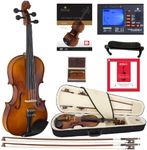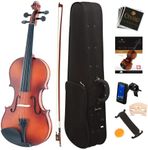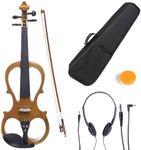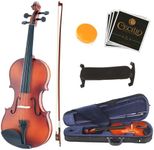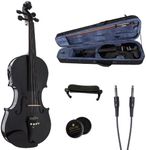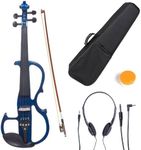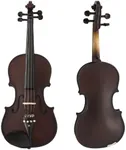Buying Guide for the Best Cecilio Violins
Choosing the right violin can be a rewarding experience, whether you're a beginner or an experienced player. The key is to understand the different specifications and how they affect the instrument's playability and sound. By focusing on these aspects, you can find a violin that suits your needs and enhances your playing experience.SizeViolins come in various sizes to accommodate different age groups and body sizes. The size of a violin is crucial because it affects comfort and playability. Sizes range from 1/16 (smallest) to 4/4 (full size). For children, a smaller size is necessary to ensure they can hold and play the instrument comfortably. Adults typically use a 4/4 size. To determine the right size, measure the length from the neck to the middle of the left-hand palm when the arm is fully extended. Choose a size that allows for comfortable playing without straining.
MaterialThe materials used in a violin significantly impact its sound quality and durability. Violins are typically made from spruce for the top and maple for the back, sides, and neck. Higher quality violins use aged, solid wood, which produces a richer, more resonant sound. Laminated wood is often used in beginner violins for its durability and lower cost, but it doesn't offer the same sound quality. If you're a beginner, a laminated wood violin might be sufficient, but as you progress, you may want to invest in a solid wood instrument for better sound.
CraftsmanshipThe craftsmanship of a violin refers to how well it is made. This includes the precision of the construction, the quality of the fittings, and the finish. Good craftsmanship ensures that the violin is structurally sound and can produce a clear, balanced tone. Handcrafted violins are often superior in quality compared to factory-made ones, as they receive more attention to detail. When choosing a violin, look for even seams, a smooth finish, and well-fitted parts. If possible, play the violin or have someone play it for you to assess its sound quality.
Sound QualitySound quality is one of the most important aspects of a violin. It is influenced by the materials, craftsmanship, and setup of the instrument. A good violin should produce a clear, rich, and balanced tone across all strings. When evaluating sound quality, listen for any buzzing or muffled sounds, which can indicate poor construction or setup. Consider your playing style and the type of music you want to play. For classical music, a warm, rich tone is often preferred, while for folk or jazz, a brighter sound might be more suitable.
SetupThe setup of a violin includes the positioning and quality of the bridge, sound post, strings, and pegs. A proper setup is essential for playability and sound production. The bridge should be correctly positioned and shaped to ensure even string height and tension. The sound post, located inside the violin, must be properly placed to transmit vibrations effectively. High-quality strings and well-fitted pegs contribute to better sound and tuning stability. If you're unsure about the setup, it's advisable to have a professional luthier inspect and adjust the instrument.
BowThe bow is an integral part of the violin and affects the sound and playability. Bows are typically made from wood or synthetic materials, with horsehair used for the bow hair. The quality of the bow can vary significantly, with higher quality bows offering better balance, flexibility, and responsiveness. When choosing a bow, consider its weight, balance, and the quality of the hair. A well-balanced bow that feels comfortable in your hand will make playing easier and more enjoyable. If possible, try out different bows with your violin to find the best match.
AccessoriesAccessories such as the case, shoulder rest, and rosin are also important considerations. A good case will protect your violin from damage and make it easier to transport. Shoulder rests provide comfort and support, helping you maintain proper posture while playing. Rosin is applied to the bow hair to create friction with the strings, producing sound. High-quality rosin can improve the sound and playability of your violin. When selecting accessories, prioritize durability and comfort to enhance your overall playing experience.
